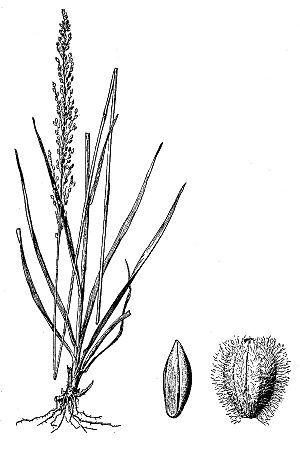Anthaenantia facts for kids
Quick facts for kids Anthaenantia |
|
|---|---|
 |
|
| Anthaenantia villosa | |
| Scientific classification |
|
| Kingdom: | Plantae |
| Clade: | Tracheophytes |
| Clade: | Angiosperms |
| Clade: | Monocots |
| Clade: | Commelinids |
| Order: | Poales |
| Family: | Poaceae |
| Subfamily: | Panicoideae |
| Supertribe: | Andropogonodae |
| Tribe: | Paspaleae |
| Subtribe: | Paspalinae |
| Genus: | Anthaenantia P.Beauv. |
| Type species | |
| Anthaenantia villosa (Michx.) P.Beauv.
|
|
| Synonyms | |
|
|
Anthaenantia is a group of plants that are part of the grass family. These grasses are found naturally in the New World, which includes North America, South America, and the West Indies. You might also see its name spelled as Anthenanthia or Anthenantia.
Discovering Anthaenantia Grasses
Anthaenantia grasses are a small but interesting group. They are known for their unique features within the large grass family. Scientists study these plants to understand how different types of grasses are related to each other and how they have spread across the Americas.
Types of Anthaenantia
There are a few main types, or species, of Anthaenantia grasses that scientists have identified. Each one grows in specific parts of the world:
- Anthaenantia lanata
- This grass is found in many places, from Mexico and the Greater Antilles (a group of islands in the Caribbean) all the way down to Uruguay in South America.
- Anthaenantia rufa
- You can find this species in the southeastern and south-central parts of the United States. It grows from Texas across to North Carolina.
- Anthaenantia villaregalis
- Anthaenantia villosa
- Similar to Anthaenantia rufa, this grass also grows in the southeastern and south-central United States, stretching from Texas to North Carolina.
What About Other Grasses?
Sometimes, scientists learn new things about plants and decide to move them into different groups. This happens when they find out that certain plants are more closely related to other types than they first thought.
For example, some grasses that were once thought to be part of the Anthaenantia group are now placed in other grass groups. These include plants now known as Axonopus, Digitaria, and Tricholaena. This is a normal part of how science works as we learn more about the natural world!

